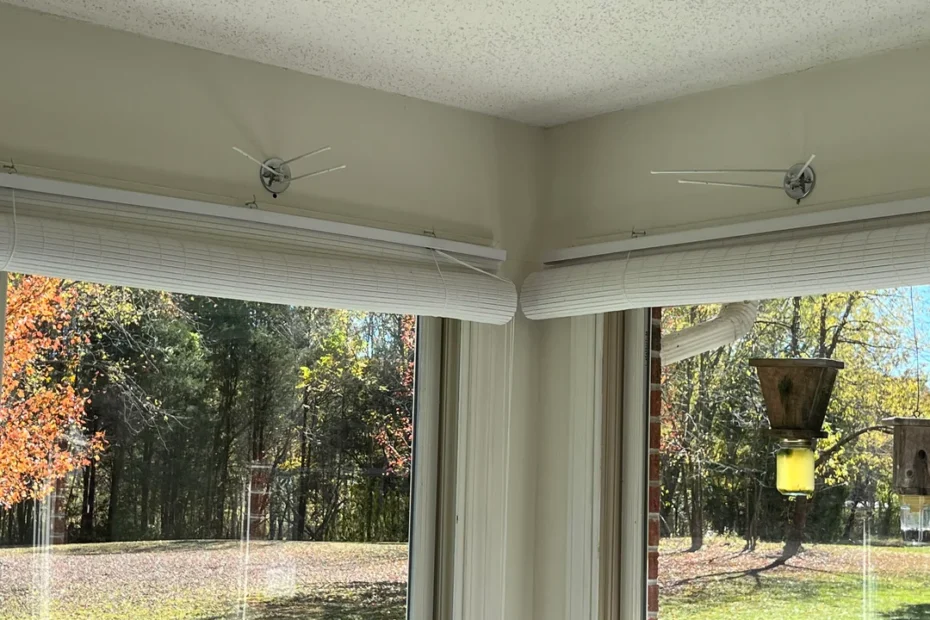A questioner said:
Hinged rods above windows in sunroom of 1968 home. Rods able to turn, about 7 inches long. What are these used for?


Owner said: Just moved into a 1968 brick ranch with lots of original fixtures. These things are pretty sturdy, but not quite sturdy enough to hang something like a planter on.
Some of the people opinions on it:
jackrats said:
They’re towel hangers.
No idea why someone would install them over their windows though.
justinizer said:
Something to hold up the tendrils of a spider plant, or another plant of some kind?
GitEmSteveDave said:
Could have been for something very light, like sun catchers.
APac666 said:
They’re laundry hangers. For air drying.
Brodgde said:
There was a curtain style where there was a ball/bunch of material in the middle that went across to a tie back in each upper corner and then down the outside of the window frame. No idea what it was called but I remember seeing them somewhere.
Teslafon said:
Swag holders. It’s like a valance, except it’s just fabric draped across those tiny rods, then to each corner, and down the wall. Sometimes people would wrap the fabric around the rods to shape a flower or bow
extraretemvitaest said:
Maybe resting places for canaries or other small birds.
fishheadbob said:
Bird perches.
random account said:
Today, I’ve seen most people have them on a vanity door under sink(s) to hang dish or wash rags
itsintrastellardude said:
Tie up some tapestry/fabric to make bohemian styled curtains? Diffuse the light and sight lines?
itsnevergoodenough00 said:
Those windows probably used to pull open at the top, or crank open. Like upper half of the window..
If you hung hand towels or tea towels there to dry in the breeze, the smell of fresh laundry would fill the room.
That’s the only thing I can think of as to why they would be up above the window.
What do you think? Let us know in the comment!
Read Also: Does anyone know what this is? It is over the basement door in our 1890’s home.
If you’ve recently moved into or are exploring a home built in the 1960s, you might have come across some intriguing and seemingly mysterious features. One such feature that often puzzles new homeowners and renovators alike is the presence of hinged rods positioned above the windows in a sunroom. These rods, typically about 7 inches long, are designed to turn. At first glance, they may seem like an archaic or obsolete part of the house. However, these small but clever devices had a very practical purpose in their time.
The Functionality of Hinged Rods
These hinged rods are, in fact, remnants of an ingenious and straightforward solution to managing airflow and ventilation in a time before the widespread use of air conditioning. Their primary function is to operate transom windows. Transom windows are small windows positioned above doors or other windows that can be opened independently to allow for ventilation.
In the context of a sunroom, where temperature regulation and airflow are crucial, these hinged rods provided an effective means to control the environment. By turning the rod, homeowners could open or close the transom windows without the need for a ladder or step stool. This simple mechanism allowed for quick adjustments to the airflow, helping to keep the room cool during hot summer days or to ventilate it on milder days without compromising security or privacy.
How They Work
The rods are typically connected to a lever mechanism attached to the transom window. When the rod is turned, it engages this lever, which in turn opens or closes the window. The ability to adjust these small windows allowed for better air circulation without the need for major window openings, thus maintaining the room’s comfort levels.
A Nod to Mid-Century Innovation
The inclusion of these hinged rods reflects the innovative spirit of mid-century home design. In the 1960s, homebuilders were keen on incorporating functional yet unobtrusive features that improved living conditions. The rods are a testament to the practicality and forward-thinking mindset of the era, focusing on maximizing natural ventilation—a key aspect before the advent of modern HVAC systems.
Modern Relevance and Potential Repurposing
While the original use of these rods was for operating transom windows, they can still serve a purpose today. For those looking to restore or preserve the historical aspects of their home, maintaining these rods in working condition can be a charming nod to the past. Moreover, they can still be quite functional, especially in homes that emphasize sustainable living practices by maximizing natural ventilation.
For homeowners more interested in modern updates, these rods can be repurposed creatively. Some potential ideas include:
Decorative Elements: The rods can be polished and used as unique, vintage-inspired decor pieces that add character to the home.
Custom Hardware: If the mechanism is robust enough, they can be repurposed to operate other small windows or shutters within the house.
Restoration Projects: Those interested in restoring other mid-century homes can use these rods as authentic parts for similar transom window setups.
Conclusion
The hinged rods above windows in a 1968 sunroom are more than just quirky remnants of a bygone era. They represent a thoughtful and practical solution to home ventilation that predated modern air conditioning. Whether you choose to preserve their functionality, repurpose them creatively, or simply appreciate them as a piece of architectural history, these small rods tell a larger story about mid-century home design and the clever ways people adapted their living spaces to meet their needs. So next time you spot one of these hinged rods, you’ll know it’s not just an oddity but a piece of practical innovation from the past.
